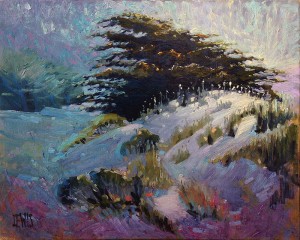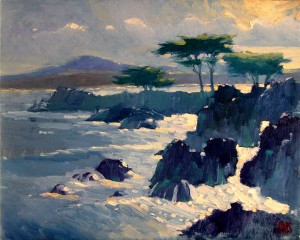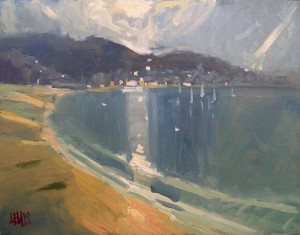Original Vision
“Sometimes people want to know if the paintings are for sale. They are not. And I don’t have any plans to sell or exhibit or take commissions…”
—Spring 2001, from a note to my father about recent plein air work
Background First

If this essay were a painting that I was about to paint on location, I would wash the canvas with a thin layer of burnt sienna, or yellow ochre, or a neutral light gray. Not all artists do this, but I find that when a bit of the canvas shows through it creates an overall tone to the work. So, too, this essay has a background hue and that hue is not neutral. That hue is the color of my very frame of mind that made its way into every act from the moment I set out upon my long plein air adventure up until this moment. I can not tell you what color it is, but I know that it is strong and it is vivid and reading this essay in its light will shed a softer light on the somewhat harsh things I must say.Of the nearly one thousand oil paintings I have completed in the last decade only a handful were painted without regard for marketplace or public opinion. Only a handful have come close to honoring the thing painted, the very thing itself.
The thing itself, is the beauty embedded in the subject of the painting. Speaking only for myself, when I am thinking clearly and am not clouded by thoughts of “will it sell?” and “will people like it?” and other deadly thoughts like that, I choose a subject that displays a clear beauty, a beauty that I can never hope to express in words. True beauty, or the perception of it, is unspeakable by its very nature, that is, one can not speak of it. And it is priceless, as well; it has no price.

Beast, behold Beauty.
The thing that catches my eye in a landscape, that certain play of light, that delightful accident of composition, that sublime gravitas of the thing itself, is Beauty itself. The thing I call beauty is beyond thought and, as I said above, is unspeakable. So, the mind, at the moment of perceiving beauty, is very present during that perception. We perceive beauty and, if only for that moment of perception, just prior to the mind commenting on the beauty, it is experienced as it is. Try as it might, the mind can not define beauty, though it wants to. Beauty is something no one can define and yet everyone knows it when they see it.
During that moment of the perception of beauty, the artist’s mind is at its best…as Artist. Now the real challenge for the artist, for this artist anyway, is to stay with the beauty and guard against, no, rage against, what inevitably happens next: the dread thoughts “will it sell?” and “will they like it?”. I am tempted to use inappropriate language in chasing these ugly thoughts away.
You might say, “but don’t you want to sell your work?” and I have nothing against selling. But I remind myself over and over again why I became a painter. Did I become a painter to sell? No, it definitely was not that. For years, my work was not displayed publicly until I opened a gallery at the urging of others. The paintings were in boxes in storage. Nor did I consider painting a hobby: It was my work, but that work had nothing to do with selling or showing.

Putting a Name on It
No, as I walked through the landscapes of my life, long before I began to paint plein air, I saw beauty. I looked at a forest and, in my mind, mixed the colors. Someday, I thought, it would be good to paint this landscape. “Plein air” was not a word I knew, at that time. Oh, yes, I knew that Van Gogh, Monet, and dozens of others, painted outdoors. It seemed remote, like a thing done long ago. An eye-opening article in Artists Magazine opened my eyes and gave me the words “plein air”. That’s it! That’s what I want to do! It was suddenly clear that I could grab onto some of that beauty and somehow put it down on something, canvas maybe, that I could show to another person and say “Look at what I see! Do you see it, too?” None of this had anything to do with selling, though. The thought of selling, or even painting for someone else, had never creeped into my mind in regards to “plein air”. The first few years of learning how to paint outdoors saw all of my paintings go into storage as soon as they were dry.

Seductive Poison
Life, or should I say the market and public opinion, has a way of grabbing on to you and, alas, a thousand paintings later, I see that I have generally failed to keep the marketplace and public opinion out of my work. I regret that deeply because every time I have listened to the market, or to another person, my work has failed to have integrity and true beauty. Every time I have only listened to my own inner vision and tried to remain firm in that while painting, my work has succeeded. By succumbing to the siren Market, I diminish my vision and dishonor myself. And for what? Money? Creating a serious body of work is my work. Money, the market, and public opinion is like a seductive poison to artistic vision, a poison that corrupts the truth and panders to a short-term vision.
However, all is not lost; there are a few paintings in this large body of work that I feel honored the beauty and the beauty only, and though they certainly do not “capture” the beauty I saw, still, perhaps, they evoke something of what I experienced seeing that beauty and came somewhere near to honoring the thing itself, Beauty.
Next Post: Savage Grace
Clarification: When I claim the plein air movement is dead, I am referring specifically to what I have called the plein air “movement“. Let me be very clear, I am not saying plein air is dead. Saying plein air is dead would be like saying music is dead; you can not kill an art form. You can contribute to the commoditization of an art form which leads to the quiet death of the original, vital movement.
Note: That small body of work I consider true to my vision will be shown in the exhibit “Private Collection: Oil Paintings by Robert Lewis” which opens this coming Friday April 11, 2014 at 7pm at the Pacific Grove Art Center, Pacific Grove, California, and will be on exhibition for 6 weeks.
See also “What is Plein Air?”


Ahhh, Robert, striking incredible work –
So what, may I ask, do you do for a living?
How is this relevant to the argument? Please be specific as to how it affects my points.
Ah, Robert, a true artists heart!
Hi Robert, Mike D. sent me your essay. I recognize your dilemma. Finding a balance between integrity and compromise is daunting. Whenever genuine, freedom of expression occurs in art and “the people” see and feel what you see and feel, that’s the veil parting and mystery revealed. Wether truth writ large or small, if it’s genuine, it matters. When we care enough about that moment of truth experienced and the artist who did the work, the right impulse is to “pony-up”. The material world sets the standard of exchange for us to follow when we are moved in some way by an artist’s work. There is honor in creating a work of art with integrity and equally there is honor in paying for it. I am glad you are committed to reflection with regard to your art making. We all benefit.
Your pal in the arts…a toast to the spirit and people of Martindale Farm…you were our artist Robert.
Deb
The dilemma is a constant for all artists, pros and dabblers alike. A resolution to this is the following: go with whatever motivates you. Some people are motivated by money, others by lifestyle, others by a fantasy they will never catch up with. It doesn’t matter. Your motivations are you. As you think, so shall you paint. It’s all good. The world is awash in plein air paintings. There are enough paintings to sink an armada. No-one ordered them, people just paint them. The world has enough art. Within a hundred years probably all your paintings will have been consigned to the city dump or someone’s attic. Maybe some will still hang on walls. It doesn’t matter. What matters is, the moment. The moment when you painted it. By the act of creation, we justify not only the paintings existence, but also that of the painter. I paint, therefore I am.
“As you think, so shall you paint.” How very true. A quote that should be memorized. I’ve always said that painting is primarily a mental activity. And, yes, it is all going to be consigned to dust sooner or later, so I say paint well and make fine dust.
I think you have dealt with the dilemma of aspiring to great art, but also aspiring to make a living; it’s too bad the monetary ideations kept intruding on the reverie while painting. All sorts of people produce art, and our societal mistake has been based on 150 or more years of art critics and experts who imposed themselves and their opinions between the artists and their audience, wherein we equate the level of the art with the story told about it and the artist. You must trust yourself to produce quality work, but then let it go; some find that a trustworthy agent or gallery can stick a value on works, freeing you from that pitfall. Work in the moment, and know that it sometimes comes out better, independent of your intent – that is just part of the magic and mystery, otherwise we’d all be Jeff Koons or LeRoy Neiman. Let your craft steer your hand, but take pleasure in the surprises and let someone else worry over the mercenary monetary particulars. This is America, so invest wisely and with some temperance; this may help free you to take the risks in your art. If others place lesser value on a work you know to be one of your finest, cherish this as a cosmic joke and move on to the next canvas, leaving behind the demons of doubt that gnaw at your confidence. Clever people without integrity make fortunes by many means including the world of contemporary art. Your responsibility is to the artwork, itself; it comes from you and through you, but it is not you. Let each piece go, like a grown child, and harbor no regrets. Don’t hoard your best works, as this reflects the fear that you may never do better, and besides, isn’t part of the path sharing your gift? Be a craftsman who works with paint, not a “fine artist”.